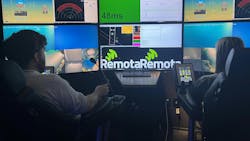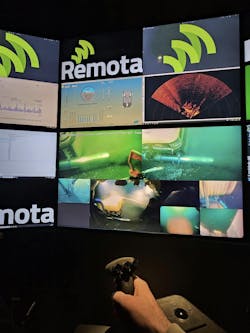Remote subsea operations picking up speed
By Johnny Lønning and Terje Nordeide, DeepOcean
As renewable and conventional energy operators venture farther offshore, more and more equipment is being placed on the seabed in increasingly deeper waters. Today, remotely operated vehicles (ROVs) are the primary method to inspect and conduct maintenance and repairs of subsea infrastructure. The ROVs are typically launched from subsea multipurpose vessels and controlled by specialist ROV operators onboard the vessel.
Operators are constantly challenging suppliers to reduce the cost and environmental footprint associated with offshore operations. Therefore, some companies have developed remote operations capabilities that allow it to control ROVs from an onshore-based remote operations center, thereby reducing operating costs, emissions and HSE risk. DeepOcean pioneered this method back in 2018 and has since then invested considerable resources into making this a reality.
Until recently, remotely controlled subsea operations had been limited to inspection and light maintenance and repair work. Heavier maintenance and repair work on subsea equipment rely on running hydraulic pumps and subsea tools, which in turn depend on a stable network connection to execute the work safely and reliably.
Connectivity as remote enabler
As 4G/5G solutions often depend on proximity to existing offshore infrastructure, a key to expanding the work scope for remotely controlled subsea operations has been to identify solutions to enhance network connectivity, bandwidth and latency.
Together with Aker BP, DeepOcean has been exploring this territory. Aker BP’s philosophy that "any work that can be performed from onshore, shall be performed from onshore" has been a key driver behind this effort.
With this in mind, Aker BP and DeepOcean have recently been testing onshore remote operation of work class and inspection class ROVs working off the IMR vessel Edda Fauna. The Remote Operations Centre is hosted by Remota near Haugesund, Norway, which is where ROV pilots and technicians operate from.
The companies assessed networks of offshore 4G/5G providers as well as various suppliers of low earth orbit satellites. This analysis has been key to identifying the optimal network solution, or combination of solutions, for operating offshore ROV operations from land. It has also created an understanding of how factors such as vessel heading, antenna shadow effects, water surface reflections and waves affect the network connectivity, bandwidth, latency and stability.
In this context, it is important to understand that remotely operated subsea operations is about transferring control room functions from the offshore vessel to an onshore control room that has identical capabilities. The ROV remains hardwired to the vessel, while the onshore-based operators control the operation.
Remote dredging
In 2024, DeepOcean completed subsea dredging operations remotely from shore for the first time. ROVs onboard the Edda Fauna vessel were utilized for the dredging, which involves excavation and sediment disposal on the seabed supported by a subsea dredging pump.
The ROV physically managed the dredging operations, and the ROV was controlled from Remota’s onshore control room. If the connection between the remote operations center and the ROV were lost, the ROV would automatically be connected to ROV operators onboard the Edda Fauna.
The dredging operation, which took place at one of Aker BP’s operated fields on the Norwegian Continental Shelf, demonstrated that conducting “heavier” remote-controlled subsea operations is safe, possible and cost-efficient when a robust connectivity solution is in place. DeepOcean and Aker BP have subsequently performed other advanced subsea operations, such as module replacement, with ROVs remotely controlled from shore.
USV enabler
This latest advancement for remote subsea operations is also paving the way for an uncrewed surface vessel (USV), which will be delivered in 2025 and enter a long-term charter with DeepOcean.
The USV can carry a medium size work class ROV or a survey/inspection ROV as its only payload. The key to successful ROV operations is connectivity. Documentation from the offshore testing will now be used as a key enabler for USVs.
About the Author

Johnny Lønning
Johnny Lønning is remote operations manager at DeepOcean, overseeing the company’s remote subsea operations. He has more than 20 years’ experience from the oil and gas industry. He started his career with Norwegian shipowner Eidesvik and subsequently joined DeepOcean as ROV pilot before moving into the role as ROV supervisor.

Terje Nordeide
Terje Nordeide is project manager at DeepOcean, responsible for planning, engineering, development and execution of various construction and IMR-related projects. He has spent the past 14 years at DeepOcean, with offshore operations on board various vessels and rigs, combined with onshore engineering and planning, including hazops and risk assessments. Prior to this, he spent 13 years as ROV supervisor at Oceaneering and five years as ROV pilot for Stolt Comex Seaway.

